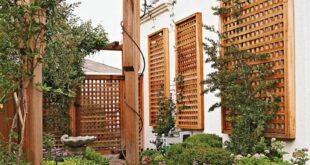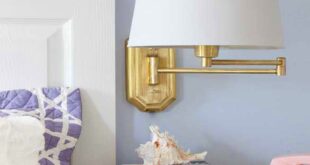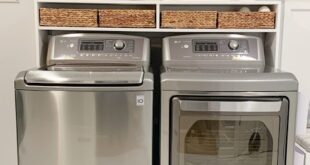
Learn how to easily cover a popcorn ceiling using classic Armstrong® WoodHaven Ceiling Planks with Easy Up® tracks and clips. No need to scrape the ceiling first! The pre-finished planks can be installed right over popcorn ceilings.
Disclosure: I partnered with Armstrong Ceilings to cover up the popcorn ceilings in two rooms in my house. All words, photos, ideas and opinions are my own.
The guest room times two update project that I have been mentioning in a few posts is completed. I know you are wondering what we have been up to that required us to remove all the furniture in the rooms as we worked in each.

We chose to do two rooms at the same time since both are visible when you are standing in the foyer. I wanted both to look the same. It is hard to show in a photo, but if you are standing in the foyer, you look right at the popcorn ceilings in these two guest bedrooms.

A few readers thought we must be adding new flooring, but that is not what we did.
I was very happy with how I decorated these rooms. What I didn’t like was…

… the popcorn ceiling in each. They collect dust and look dirty after time and cannot be easily cleaned without the popcorn raining down into the room.
It was time to give them a new look.

What we did was like laying a new wood plank floor, but in reverse – on a ceiling using Armstrong WoodHaven Ceiling Planks.
Covering a Popcorn Ceiling With Pre-Made and Painted Ceiling Planks
Click for Table Of Contents
When it comes to removing popcorn ceilings, I tried the budget-friendly water and scraping removal method when I made over the guest bath a few years ago. The method works, but is extremely messy and I did expose a very uneven ceiling. For the guest rooms, I didn’t want to go this route to find uneven or damaged ceilings underneath the popcorn.
Unless you are sure about the state of the ceiling that is under the popcorn layer, you may be opening a can of worms as one contractor told me, especially in older homes.
The popcorn could be hiding a multitude of sins – water damage, an uneven surface and more.
One reason popcorn ceilings are used in homes is that they are an inexpensive way to hide imperfections, cracks, and marks. Since the three-dimensional texture is coarse and casts shadows, it can disguise or even completely cover those older, shoddy repair jobs and natural aging. No one would ever know until you try to restore the original smooth finish.

This is clearly the case in my house. We were far better off covering the popcorn ceiling rather than removing it.
That is what we did to update the two guest room ceilings… we covered the popcorn up.

It looks beautiful – classic and cottage-y. I love it.
Armstrong Ceilings offers an Easy Up® track and clip system which makes installing beautiful ceiling planks over your existing popcorn ceilings very doable. We chose the smooth painted white planks, but there are many color and wood texture options available.

If you want to no longer see these dated ceilings in your home, or just want to add classic character to any room, then keep reading to see how Ed and I installed this Easy Up system in our guest rooms. It was far easier than we thought.
WoodHaven Ceiling Planks with Easy Up Track and Clip Installation TIPS:

Ed and I are DIY’ers but we’re not at the same level as the pros you see on home improvement shows. We definitely don’t have all of the cool contractor tools you see being used on HGTV, but found a few ways that made installing the ceiling planks easy for us.
When we decided to use the WoodHaven ceiling planks to cover the popcorn ceiling, we did some research online and also read all of the instructions included with each box of the planks.
What helped us the most though was watching wood working pro Ron Hazelton’s video a few times where he shows how to attach the planks over a sheetrock ceiling.
We also watched the installation video on Armstrong’s website. With the Installation Instructions booklet that came with the planks and the videos, we were confident we could install the planks without any problems.

Once we started the project, it was far easier than we thought.
The hardest part of the entire project for both rooms was cutting the crown molding corner joints after the ceiling planks were installed. Thank goodness for caulk. 🙂 Installing the planks was so easy compared to cutting crown molding corner joints.
The Easy Up System

The Easy Up System is made up metal tracks and clips. The ceiling planks are medium density fiberboard planks made to go over drywall, plaster, joists or even drop ceiling grid.
You start installation by attaching the metal tracks to the ceiling joists using 2.5″ wood screws. Then you attach metal clips to each track. You could just do one clip per track, attach the plank, then repeat.
We found it easier to attach 3-4 clips per track at a time so you could focus on installing the planks. Our planks were 5″ wide so 3-4 clips worked well to keep everything in the same general area.

The final step is to install the planks, inserting the tongue into the groove of the previously installed planks, then securing the next clip into the groove of the new plank.
- WoodHaven Planks are pre-finished. No need for staining or painting.
- When the ceiling is installed, it only lowers the ceiling height by approx. 1- inch.
How To Install WoodHaven Planks Using Easy Up® Tracks and Clips

- Read the Installation Instruction Booklet that comes with the planks throughly. (Armstrong recommends going online to read the most up-to-date installation instructions) and watch the Ron Hazelton video so you understand the process in advance.
- With the popcorn texture on the ceiling, we found it hard to get a good reading of where the joists were using a stud finder. Since the ceiling is going to be covered, don’t be afraid to drill a few holes in the ceiling to confirm the joist location.
- When cutting your plank pieces, do not to use planks that are less than 26 inches in length to ensure that planks are attached to the track with at least two clips.
- The screws that come with the planks were designed for installing the track directly to furring strips. Since we were going through a layer of popcorn and sheetrock, we bought 2-1/2″ long wood screws.
- Use the cardboard from one of the boxes in which the planks came to make a template, if needed, for installing the planks around light fixtures and other ceiling penetrations. You may also need to purchase longer screws when you reinstall those ceiling fixtures.

supplies needed:
- Armstrong WoodHaven Ceiling Planks in Painted White: Item # 1148B – The planks come 10 planks to a box that covers 29 square feet.
- Circular saw
- Miter saw
- Jig saw (for cutting planks around light/ceiling fan fixture
- Drill and drill bit slightly smaller than the size of wood screws
- Wood screws – we used Power Pro Interior Wood Screws 9 x 2-1/2″
- Long level
- Chalk line
- Stud finder
- Tape measure
- Rubber mallet
- Dust mask
- Safety glasses
- Wood shims
- Painter’s tape
- Pencil
- Scrap piece of cardboard from plank box
- Crown molding – enough to go around the perimeter of the room / finishing nails /recessed nail punch / hammer
- Semi-gloss paint for crown molding. I used SW Pure White #7005
- SPACKLE and sandpaper to cover nail holes on crown molding
Step 1: Measure the Square Footage of Ceiling
Using a measuring tape, measure the width and length of the room, to determine how many boxes of WoodHaven planks you will need. Order a little bit more square footage than needed just in case you make a wrong cut.
Step 2: Find and Mark the Ceiling Joists

Using a stud finder, locate the ceiling joists and mark the joists with a chalk line. (If installing the ceiling planks by yourself see the end of this post for tips on how to do this successfully.)
Find the studs in the wall and mark with painter’s tape. This will help you when it is time to attach the crown molding where the wall meets the ceiling.
Step 3: Screw Metal Tracks into Ceiling
Once your ceiling is marked with chalk lines you can install your first track.

The first track should be attached 2″ from the wall. Subsequent tracks should be spaced at 16-24″ intervals. If you need more than one track to span the ceiling, attach the second track at least 1/8″ away from the first so there is room for the clips to slide back and forth. You should have a 1″ overlap where the first track in the line meets the second.
Your tracks will run perpendicular to your joists meaning they will intersect with the chalk lines you snapped.
Be sure that your tracks do not cross over your light fixture holes.
If necessary, adjust your tracks by reducing space between them to avoid having a space greater than 24 inches between tracks.

Unless the track length is the same length as your ceiling, you will need to make cuts. The tracks can be cut with a hacksaw, sabersaw or snips.
We added a few cut tracks around the light fixture and air duct.

- Use a long bubble level across each track to make sure it is level. If not, loosen screws and place shims behind the tracks where needed in order to level each track.
Step 4: How Wide Should the Starting Plank Be?
Once all the tracks are up, you have to figure out the width of the room perimeter planks so the planks will fit across the entire ceiling. You’ll want to place the least seen “thinner” planks on one edge of the room, and have the middle be full width planks.
How wide should that starting plank be? There is a formula in the instructions that you’ll need to follow to figure out that measurement for your space. Simply follow the formula to figure out how wide it needs to be. I’ve also included the calculation below. Ed says to just take it a step at a time without too much analysis and it will work out perfectly.
- Measure the length of the room (in same direction as the individual tracks have been installed).
- Divide the length in inches by 5
- Multiply the remainder by 5
- Add 5 to the total and divide by 2 to get the desired width of the first and last row of planks.
- Sample:
- Let’s say your room is 11′ (132″)
- 132/5 = 26.4 (.4 is the remainder)
- .4*5 = 2
- (2+5)/2 = 3.5″
Step 5: Cut Tongue Side Off of First Border Plank

Cut the tongue side off of your first border plank.
The border wall planks are the first and last planks installed on your starting and finishing walls. Once your border planks are cut to size, install them 1/2 inch away from the wall, leaving 3/4″ gaps at the ends to allow for wood expansion.

- Use one screw as pictured above to hold the border board in place. The screw will be covered by crown molding later on.
- Only the border planks will need screws.
Next, attach a clip to each track and push the clips into the groove of the plank.
Step 6: Start Attaching Ceiling Planks
Install the planks with staggered seams and continue adding on to the ceiling by connecting the tongue and groove planks.

The rest of the ceiling will go fairly quickly, especially if you have two people working on it!
Depending on the size of your room, you will have to make cuts in your planks to stagger them. Measure the empty space on each row, mark it with a pencil and cut to size using a saw and install!

Close up of a clip inside the groove on the plank.
Step 7: How to Cut Planks to Fit Around Light Fixtures
When you get to the section of the ceiling where there are holes for light fixtures and or HVAC elements, you will have to cut circles in the planks.

This may seem hard, but with a few tools it is pretty easy.

Make a Cardboard Template:
First measure the diameter of the hole. Use this measurement and a compass to draw the size circle needed on the cardboard. Cut out with a pair of scissors.

Attach a plank over the hole and then place the cardboard circle over hole. Trace around the circle with a pencil.

The pencil line is where you need to cut.

We used a jigsaw to cut the circle out of the plank.

Repeat the process on another plank to fit around the hole. Then continue adding the planks to cover the ceiling.
Cutting Tip: When using any saw on the planks be careful not to get scuff marks on the planks. If the saw leaves any grey markings use a damp rag with detergent on it to remove them.

Step 8: Continue Adding Planks
Clip each plank to the track, repeating the process until the ceiling is complete. Always leave approximately 3/4″ gap from the walls at the ends, which will be covered by the trim or crown molding.

The final row will be just like the first row… screwed directly into the metal track (and cut along the length of the plank). Again, be sure to leave 3/4″ from the edge. This gap will be covered with trim or crown molding.
Step 9: Add Trim or Molding
When installing the crown molding, you will only be attaching it to the wall not the ceiling. We used finishing nails, a recessed nail punch, and a hammer to attach the molding around the room.
Two crown molding installation tips if you’re not a pro:

- If you don’t have a miter saw, buy corner blocks where wood is sold at the home improvement store.

When these blocks are installed in each corner of a room using caulk, no compound miter cuts are needed. Only flat, straight cuts that you can do with a circular or hand saw.

Once up, apply caulk all around the blocks and molding to make it….

…all look seamless.
Another option for easier crown molding corner cuts:
- If you have a miter saw, make crown molding corner cut samples. These will help take the guessing game out of cutting corner joint cuts correctly. This is a crown molding cutting tip from Sandra at Sawdust Girl. Her post about crown molding makes the compound cutting process make sense.
How to Install WoodHaven Ceiling Planks By Yourself

Installing the WoodHaven Ceiling Planks is easier done with two people, but not impossible if you are going to install the ceilings by yourself. This is pretty much what Ed did. I helped with painting and running for tools, and taking photos, but he did most of the work by himself.
When working by yourself, here are some handy installation tips:
- Attach the border tracks first. Doing this will help with making the chalk lines.

Don’t screw the screws in all the way around the border tracks around the room. Leave them halfway out until you mark all the ceiling chalk marks.

You can use the screws to attach one end of the chalk-line as you carry the other end to the opposite side of the room to snap the line.

- Make spacers out of scrap wood. To make it easier to space the tracks evenly across the ceiling, cut scrap pieces of wood to the joist spacing measurement. Our joists were 18″ apart.
This made it easier for Ed working by himself, so he didn’t have to measure every time he added a new track. It also meant he could hold the new track against the two spacers, ensuring the track was precisely parallel to the previously installed track.

- Use two ladders. It will save you lots of time going up and down. When up on one ladder, you can simply reach for what you need when placed on second ladder.
The New Plank Ceiling After Reveal
Later this week I will share a walk-through video of the upstairs of my house and you will get to see the ceilings in more detail.

The new white planks on the ceilings have changed the vibe of the rooms to more classic and cottage feeling.

No more dusty, dirty looking popcorn.

Now when family and friends stay with us and are lying in bed, they will look up and see pretty ceilings. 🙂

Where to Purchase Armstrong WoodHaven Ceiling Planks
Planks are available at your local home improvement store. Click here to see which Armstrong Ceiling distributors are located in your area.
I hope reading how Ed and I did this project and had great success inspires you to cover your popcorn ceilings or if you simply want to add a classic touch to any ceiling in your home.




